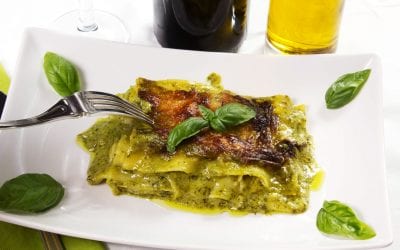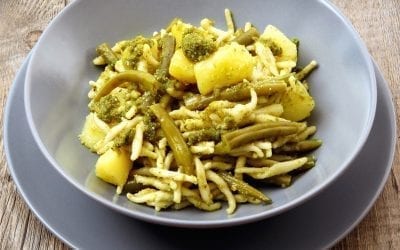Italian Pesto
Pesto Buy Online to bring Italian tradition on your table!
Pesto is a traditional typical sauce that originates from Liguria, the region that has Genoa as its capital.
Discover Italian Pesto
The key ingredient to create the perfect pesto is basil, “Ocimum basilicum”, or, more specifically, the “Basilico Genovese,” basil from Genoa, which is called “baxeicò” or “baxaicò” in the Ligurian dialect.
The most famously used basil for producing pesto is the basil cultivated in Pra’, an area located in the west of Genoa, between Pegli and Voltri.
The Ligurian climate, especially in the area of Pra’ creates a particularly suitable habitat for the cultivation of the basil.
The basil cultivated in Pra’ has been declared as the best variety of this herb, due to the perfect balance of taste and flavour. The reason of this quality depends from many factors. The microclimate is the most important: Pra’ is near to the sea, where the sun is shining, but there is a breezy climate. Also the expertise of the farmers of the basil from this area are very well-known.
The leaves of this quality of basil are tender, light green, medium-small. Their shape is usually of an oval convex. The aroma is delicate and there are no traces of mint aroma which is typical of other basil varieties.
The basil from Pra’ is grown either in outdoor fields or in a sheltered environment, like tunnels and heated greenhouses.
The name of Pesto derives from the word “pestâ”, of the dialect of Genoa which means to crush or to pound. According to the tradition, preparing the Pesto it is necessary to ground the basil together with the other ingredients in a marble mortar through a circular motion of a wooden pestle.
The ingredients for a perfect pesto are the young leaves of the basil of Pra’, the extra virgin olive oil of the Ligurian Riviera, because the oil produced in Liguria is typically mild (it doesn’t ” pinch ” and not “stick to the throat “) it is not very fruity and its quality has a protected designation of origin according to the European Union (PDO). Other ingredients are Italian pine nuts, Parmigiano Reggiano cheese, “Fiore sardo” which is a cheese produced in Sardinia using sheep’s milk, coarse sea salt, and garlic from Vessalico, which is a place in Liguria, in the province of Imperia. This garlic is less intense and more digestible.
The basil leaves have to be washed and left to dry, but one must pay attention to not crumple them, to prevent the rupture of vesicles, resulting in blackening and altered the taste.
The garlic (about 1 clove per 30 leaves of basil) is marbled in a mortar. Then the basil leaves are added, with some salt, using coarse salt works the best as it helps in shredding the leaves, which will thus crush by rotational movement of the pestle against the mortar wall.
When the basil drips green liquid and looks like a paste, the pine nuts and the previously grated cheese must be added. Continue to mix well with circular movements of the pestle. Only when the mixture is a cream, add the extra virgin olive oil that is used as an antioxidant.
The process should be very quick in order to avoid the oxidation of ingredients. The pesto should appear as a thick cream with a light green uniformed color. All the ingredients are mixed to obtain a balance taste.
Recipes Italian Pesto
Pesto Gnocchi
Pesto Gnocchi Ingredients: 600 gr of Potato Gnocchi 30 leaves of fresh Basil 1 pinch of salt 30 gr of Pine nuts 10 gr of Pecorino Romano cheese 30 gr of Parmigiano Reggiano cheese Extra Virgin Olive Oil Preparation: To prepare Pesto...
Pesto Lasagne
Pesto Lasagne is a recipe that combines two typical dishes of Italian culinary tradition: fresh egg pasta and Ligurian pesto. The bechamel sauce is a must in this recipe, which with its velvety touch makes everything more creamy and harmonious. The lasagna with...
Pasta with Pesto
The basic recipe for pasta with pesto (basil sauce) is very easy if you have the right ingredients. Put in a pot 2 liters of water and warm up until it bubbles. Add a spoon of salt and taste it. Only after that, add the pasta and continue to cook without lowering the...





